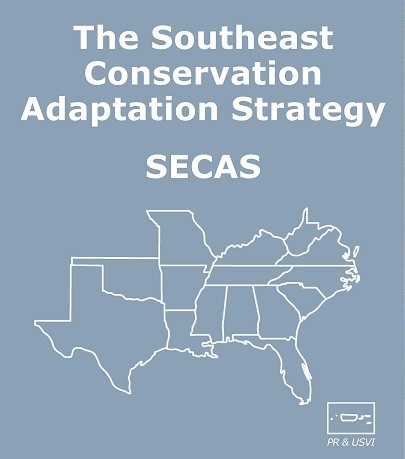2021 Report to the SEAFWA Directors

Each year at the Southeastern Association of Fish and Wildlife Agencies (SEAFWA) annual conference, SECAS provides a briefing to the SEAFWA Directors on achievements for the past year and directions for the upcoming year. I wanted to share the 2021 report to SEAFWA Directors that was presented by SECAS Steering Committee Chair Robert Boyles last month. Excerpts from the full report are below.
SECAS achieved several notable accomplishments in the last year, contributing to a national focus on the partnership and SEAFWA as a model for voluntary, collaborative, landscape scale conservation for the 21st century.
Perhaps most notable was the establishment, by the SEAFWA Directors at the 2021 Spring Director’s meeting, of the SECAS Executive Steering Committee as an official “Directors Committee” of SEAFWA. The purpose of the Steering Committee is to provide oversight and strategic direction to the SECAS partnership. This is a unique governance arrangement that formalized a state-federal oversight board, with participation from 5 State Directors and 1 Federal agency Regional Director to help guide, direct, and sustain the efforts and accomplishments of this important landscape scale conservation initiative.
The SEAFWA Directors’ leadership was recognized and emulated by regional associations in the Midwest (MAFWA) and the Northeast (NEAFWA), which are implementing or considering similar governance arrangements to help advance landscape scale conservation initiatives in those regions.
Special recognition is warranted for the SECAS Steering Committee for its contributions of leadership and support of the SECAS partnership:
- Robert Boyles, South Carolina Department of Natural Resources, Chair
- Sara Parker Pauley, Missouri Department of Conservation
- Eric Sutton, Florida Fish and Wildlife Conservation Commission
- Ted Will, Georgia Wildlife Resources Division
- Bobby Wilson, Tennessee Wildlife Resources Agency
- Leopoldo Miranda-Castro, U.S. Fish and Wildlife Service
In addition to this important accomplishment, SECAS continued its focus and action in three key areas:
1) Implementing recommendations from the 2021 SECAS Futures Project
A holistic evaluation of the SECAS partnership was completed early this year. In addition to recommending creation of the steering committee, the evaluation produced other specific recommendations in critical areas to refine and sustain the SECAS partnership and to emphasize the value of SECAS to partner organizations. A subset of overarching recommendations was highlighted by the Steering Committee for immediate implementation and progress was completed on each of the following:
-
SECAS Statement of Purpose approved by the Steering Committee
-
succession planning for key staff and Steering Committee leadership
-
analysis of conservation partnerships to help guide deeper engagement-project initiated
2) Updating and improving the products and tools of SECAS
-
The Southeast Conservation Blueprint was updated to a 2021 version that includes more consistency in the indicators of ecological condition and a new viewer to help guide Blueprint users in using the Blueprint.
-
The SECAS Goal Report, which tracks progress toward the SECAS goal of a 10% or greater improvement in the health, function and connectivity of Southeastern ecosystems, was updated to a 2021 version, incorporating the latest metrics to demonstrate progress and highlighting areas needing more focus.
-
SECAS expanded critical Blueprint User Support functions through additional staff capacity. Supporting the users of the Blueprint and other tools and products of SECAS is a key effort in returning value to partners. More than 100 different organizations have used or are in the process of using the Blueprint to support conservation decisions.
3) Broadening and deepening engagement through SECAS
-
SECAS sponsored a special symposium at the SEAFWA annual conference titled SECAS and 30x30: Identifying opportunities and defining outcomes in the Southeast. This was the first formal and inclusive dialogue among fish and wildlife agencies in the Southeast around potential conservation outcomes of the America the Beautiful campaign. The symposium sets the stage for further examination to align priorities to take advantage of momentum created through the national campaign. The virtual symposium was attended by more than 80 participants and featured in-depth discussions of how the Southeast is defining what it means to “conserve.” Missouri Director Sara Pauley characterized the America the Beautiful opportunity through SECAS as “the chance of a lifetime to continue what we’ve already begun.” A treasure trove of perspective and comment was compiled in facilitated breakouts and will be synthesized to provide specific direction to SECAS through the Steering Committee in the coming months. Continuing updates will be provided on the SECAS website on progress related to how SECAS can leverage this momentum to advance conservation in the Southeast.
-
SECAS expanded its engagement with the SEAFWA Wildlife Diversity Committee to support efforts to standardize State Wildlife Action Plans (SWAPs) to more consistent language for defining threats and actions across jurisdictional boundaries. SECAS is helping States become “RAWA-ready” by using the Southeast Blueprint and other tools to provide a regional perspective for implementing SWAPs at biologically relevant scales.
-
During 2021 SECAS conducted dozens of briefings for agencies and organizations throughout the nation on the importance of landscape conservation and the collaborative approach of SECAS. The Steering Committee is in the process of scheduling a specific SECAS briefing for Department of Interior Secretary Deb Haaland later this fall.